Painter and printmaker Max Angus on her love for lino cuts and an etching press called Hettie. Words by Diana Crampton. Pictures by Manu Palomeque

Max Angus’s studio is an insulated timber workshop in the garden. The weatherboard is painted black with white windows and looks just like a mini cricket pavilion.
She says “Being small, it is easy to keep warm in the winter. If even with the heater on the thermometer is still around 0ºC, I have to work in the house. The workshop is just large enough to have everything I need at hand.”
Max lives not far from Dover, so access to London, its exhibitions, theatre, restaurants and like-minded people is easy, although she points out: “Kent has been forgotten over the last 20 years. That is probably its charm; like many of the beautiful areas of the UK, it has very small, isolated villages which are wonderful for a holiday or a visit.”
Max has always known she wanted to be an artist: “When I was at school one of the English essays was ‘what would you like to do when you leave school?’ My answer was that I wanted to be a freelance artist and I added: ‘I do not want to take commissions or have to work for anyone else.’ There was absolutely nothing else I wanted to do. I was already exhibiting in adult exhibitions.”

However, there were “great arguments” with her father about her calling. “From then on it seemed to be my mission to make it to art college and my father’s to ensure I did something more suitable for a young lady. The compromise was that I left school, got a job and left home. I had a full-time job in an office and worked part time in the evenings. There was now little time left to create artwork.”
The family moved from London to Kent when Max was at school, and her grandparents, who had retired to the coast, lived next door. Max enjoyed her working life, but itched to get back into art. “Part-time art degree courses had been advertised but I had to do a Foundation Course first and unfortunately these were full time.
“I approached South Kent College and the tutor suggested I could gain the experience of being a mature student and keep my job by attending a one day a week A-level Art and Design and GCSE Printmaking courses.
“We only had a morning on linocuts but I was hooked. Linocuts were considered to be the lower end of technical printmaking but I really enjoyed the effect they made. My own painting could be too detailed.”
She applied for The KIAD part-time degree course at Canterbury, which included printmaking in the prospectus. Unfortunately, just as she started the course the college decided not to continue with the printmaking.
“It did feel as if another door had closed and I failed to finish the first year,” she says. “Then there was a linocut exhibition in London by the Grosvenor School artists of the 1920s and 30s. They believed linocuts and printmaking was the way an artist could earn enough for their daily needs and had a vision of the artwork being affordable so every home in the country could have an original piece of art.
“About five years ago, my husband acquired a project restoring an Albion Printing Press, 1859. Up to then I had been using a mangle converted into an etching press. The Albion presses are huge, cast-iron direct presses often weighing three quarters of a ton.
“When the Albion was restored, I imagined installing a new, larger prestigious studio or perhaps a modest extension to the old studio. The workshop company looked at the Albion and looked at the studio. We agreed to try the Albion in the old studio, but if the base of the workshop sunk, then the new workshop would need to be on a substantial base. The furniture in the studio was rearranged and the Albion press, named Hettie (made by Henry Watts), has sat in the corner ever since. “
Max shows me the lino cuts which are preparatory for her work. One of the plates has five colours and she says that her print making is done in a completely different way from other printers: some linocutters do reduction prints, but “that produces completely different effects, which can be quite thick with ink, whereas mine are simple in layout.”
Get in touch
The following galleries in Kent hold works by Max Angus:
Lilford Framing, 76 Castle Street, Canterbury CT1 2QD
Taylor Jones & Son, 94 High Street, Deal CT14 6EE
Lombard Street Gallery, 2 Lombard Street, Margate CT9 1EJ



























